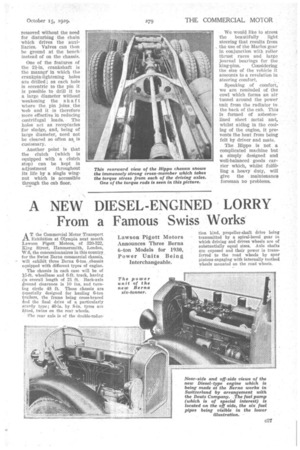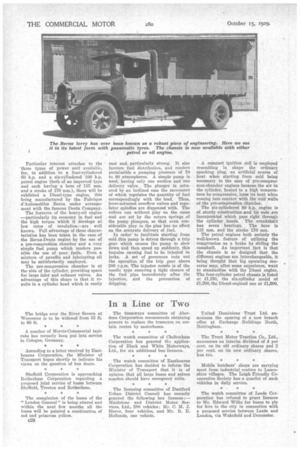A NEW DIESEL-ENGINED LORRY From a Famous Swiss Works
Page 65

Page 66

If you've noticed an error in this article please click here to report it so we can fix it.
Lawson Pigott Motors Announces Three Berna 6-ton Models for 1930, Power Units Being Interchangeable. AT. the Commercial Motor Transport Exhibition at Olympia next month Lawson Pigott Motors, of 320-322, King Street, Hammersmith, London, W.6, the concessionnaires in this country. for the Swiss Berna commercial chassis, will exhibit three Berna 6-ton chassis equipped with different types of engine.
The chassis in each case will be of 1.5-ft. wheelbase and 6-ft. track, having Cm overall length of 21 ft. Back-axle ground clearance is 10 ins. and turning circle 48 ft, These chassis are specially designed for hauling 6-ton trailers, the frame being cross-braced And the final drive of a particularly sturdy type; 40-in. by S-in. tyres are fitted, twins on the rear wheels.
The rear axle is of the double-reduc tion kind, propeller-shaft drive being transmitted by a spiral-bevel gear in which driving and driven wheels are of substantially equal sizes. Axle shafts are exposed and their power is transferred to the road wheels by spur pinions engaging with internally toothed wheels mounted on the road wheels.
Particular interest attaches to the " three types of power unit available, for, in addition to a four-cylindered 00 h.p. and a six-cylindered 100 h.p. petrol engine (both of an improved type and each having a bore of 115 mm. and a stroke of 170 mm.), there will be exhibited a Diesel-type engine, this being. manufactured by the Fabrique d'Automobiles Berne under arrangement with the famous Dents Company.
The features of the heavy-oil engine —particularly its economy in fuel and the high torque which it develops at low rates of revolution—are well known. Full advantage of these characteristics has been taken in the case of the Berna-Deutz engine by the us.i of a pre-compression chamber and a very simple fuel pump which renders possible .the use of poor fuels. Even a mixture of paraffin and lubricating oil may be satisfactorily employed.
The pre-compression chamber is at the side of the cylinder, providing space for large inlet and exhaust valves. An advantage of this shape is that it results in a cylinder head which is easily cast and, particularly strong. It also favours fuel distribution, and renders permissible a pumping pressure of 70 to 80 atmospheres. A simple pump is used, having only one suction and one delivery valve. The plunger is actuated by an inclined cam the movement of which regulates the quantity of fuel correspondingly with the load. Thus, lever-actuated overflow valves and regulator spindles are dispensed with. The rollers run without play on the cams and are set by the return springs of • the pump plungers, so that even considerable play in the pins has no effect on the accurate delivery of fuel.
In order' to facilitate starting from cold this pump is driven through a trip rear which causes the pump to slow down and then speed up suddenly, this impulse causing fuel to be injected in jerks. A set of governors cuts out the operation of the trip gear above 200 r.p.m. The injector nozzle is of the needle type ensuring a tight closure of the fuel pipe immediately after the injection, and the prevention of dripping. A compact ignition coil is employed resembling in shape the ordinary sparking plug, an artificial source of heat when starting from cold being necessary in the case of pre-compression-chamber engines becausel the air in the cylinder, heated to a high temperature by compression, loses its heat when coming into contact with the cold walls of the pre-compression chamber.
The six-cylindered 80 h.p. engine is of sturdy construction and tie rods are incorporated which pass right throngli the cylinder heads. The crankshaft has seven bearings. The bore is 115 mm. and the stroke 170 mm.
The petrol engines both embody the well-known feature of utilizing the compression as a brake by sliding the camshaft. An important fact is that the chassis is so designed that the different engines are interchangeable, it being thought that big operating concerns may, after some experience, want to standardize with the Diesel engine. The four-cylinder petrol chassis is listed at £1,150, the six-cylinder model at £1,200, the Diesel-engined one at £1,500.




























































































































